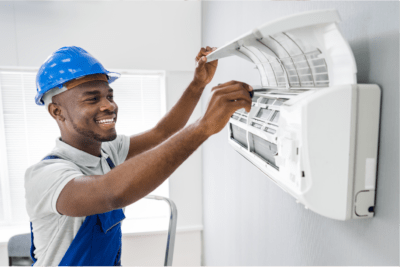Once the summer heat hits, the last thing you want is to be stuck with a high-efficiency air conditioner that isn’t working. That’s why it’s important to stay ahead of the game. Here are a few things you can start doing now to make sure your equipment is in perfect working order when you’re ready to start using it.
Change the Filters
Start by cleaning or replacing the air filters in your HVAC system. This is something you should be doing seasonally, but especially before AC season. In most cases, you can find the slot for the filter right next to the system’s air handler (the large metal box with the fan and fan motor). There may also be a filter in the return vents—these are typically rectangular vents on the wall or ceiling. When these filters get too clogged, dust and other contaminants can get into your HVAC system and restrict airflow by jamming the fan motor, valves, or other moving parts, which, in turn, strains the system. Changing these filters will help to ensure the life and function of your AC unit.
Clean the Outdoor Unit of Your High-Efficiency Air Conditioner
Head outside and to tackle your AC’s condenser unit. This is the large metal box with a fan inside and what looks like grills on top, usually found outside your home. The first thing you should do is clear away leaves, yard waste, dirt, and anything else that may have accumulated around the unit. Next, take a look inside to see if there’s any debris around the condenser coils. If so, lift off the top of the box and use a soft brush to gently clean the coils and remove any debris or water that has collected at the bottom. (Make sure power to the unit has been turned off first.)
Check Condensation Lines
Your AC unit has a condensation line that runs from your indoor unit to outside to carry away condensation. You’ll usually find a copper or white PVC pipe near your condenser unit outside—this is the end of your condensation line. If this pip gets clogged, it could back up into your AC unit or even worse, your home. To avoid this messy and expensive problem, check where the pipe drains outside and ensure everything is in working order.
Check Your Ductwork
A leak in your ductwork means your HVAC systems have to work harder. Take a look at your ducts for any obvious issues—check for disconnected joints (the most common spot for leaks), small holes or tears, and separated pieces. Sealing leaks will not only lead to better cooling, but also savings on heating and cooling costs.
Test It Out
Once everything is cleaned up, turn the AC on and check your vents to make sure cool air is actually coming out. If something doesn’t seem to be working right, now would be a good time to schedule a technician visit to investigate further.
Upgrade Your Energy-Efficient Cooling Equipment
If all else fails, it may be time to upgrade your equipment. Installing a new high-efficiency air conditioner will do more than keep you cool and comfortable through the summer—it also reduces your energy consumption, which means more in your pocket when it comes to utility bills. Wondering which AC unit works best for your home? Get in touch with us and we’d be happy to help!




